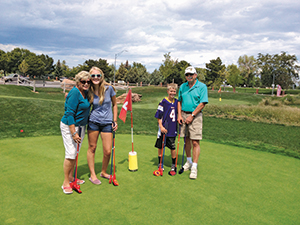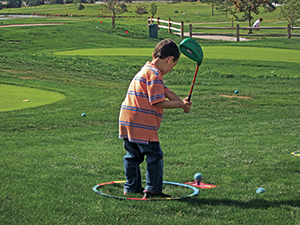The big idea of the mini course

Having a blast on the Cattail Creek Mini Course (Photo: Kelly Smith)
Imagine a standard golf outing experience: 18 holes spread across sprawling fairways, a small white ball, a wide selection of clubs from which to choose.
Now, subtract a couple hundred yards from each hole, increase the fuzziness and size of the ball, expand the cup to 6 inches, add in a roller (putter) and a launcher (wedge) — this is the basic idea of a mini course.
While it may bring up thoughts of mini golf, the mini course concept resembles that of traditional golf rather than putt-putt.
The idea of a mini course was inspired by Starting New at Golf (SNAG) equipment, which is similar to traditional golf clubs, save for the shorter club lengths and oversized club heads. More than 8,000 schools worldwide use SNAG equipment.
“The product is great,” says Kevin Atkinson, a golf course architect at Phelps-Atkinson Golf Design in Littleton, Colo. “It’s great for teaching people how to play golf, and we felt like there was an opportunity to use that type of equipment in the real setting of a golf course.”
That’s where Dennis Kling and the Cattail Creek Golf Course come in. The superintendent of The Olde Course and Cattail Creek Golf Course in Loveland, Colo., received his first lesson about SNAG equipment in early 2012 from his town’s elementary school.

To resemble the topography of a traditional course, ponds dot the mini course’s perimeter. (Photo: Kevin Atkinson)
Around that same time, he was trying to figure out what to do with a several-acre gravel parking lot and coming up with ways to make extra revenue, as the facility was barely breaking even and still trying to dig its way out of recession-era lows. Originally, Kling and his team had planned to build a four- or five-hole pitch-n-putt area. However, free to the public, a pitch-n-putt space would have resulted in no additional revenue.
Kling enlisted the help of Atkinson, who says he was excited about the prospect of building the unique mini course. By July 2012, the Cattail Creek Mini Course was born.
“We thought, ‘We need to make ourselves relevant and fresh,’ which is why we rolled the dice,” Kling says.
Atkinson agrees. “We need to grow the game of golf, plain and simple,” he says. “In designing this course, we thought about the 91 percent of the population that doesn’t play golf. We thought about what barriers are preventing them from wanting to learn how to play.”
Golf’s “bunny slopes”
Because the mini course introduces the basic concept of golf, Kling says the course is designed for almost all ages, beginning with children as young as 5 years old.

The Mini Course at Cattail Creek provides a multigenerational activity for families in the area. (Photo: Kevin Atkinson)
“It’s like the building blocks,” Kling comments. “If you start them at a mini course from ages 5 to 8, we’re hoping they go from the mini course to Cattail Creek (a nine-hole par-3 course), and then they’ll gain the confidence and want to play the 18-hole course. We’re hoping we can grow a golfer.”
Atkinson likens the mini course to the “bunny slopes” of the nearby ski resorts. “You can learn and have good success without having to go down the double diamond,” he says.
In addition to promoting the game of golf, Kling says he’s also seen the mini course bolster social interactions among participants.
The Cattail Creek Mini Course, for instance, plays host to a range of visitors, including sugared-up youngsters celebrating birthday parties, high school kids out on dates, working-age folks participating in corporate team-building activities and grandparents enjoying a day outside with their grandkids.
Kling says that during the summer months, the mini course can get pretty busy, with anywhere from 100 to 150 golfers per day on the weekends, for a total of about 6,000 rounds per season.
“Sometimes we’ll even have to do a tee time for the mini course, or we’ll have a line four deep waiting to get on the course,” he says.

The larger club head and ball serve as the building blocks for youngsters who want to learn how to golf. (Photo: Cattail Creek Mini Course)
Early on, however, many of Loveland’s 75,000 residents didn’t even know what a mini course entailed. To educate the public, Kling and his team have worked tirelessly getting the word out, using flyers, word of mouth and multimedia platforms, such as the course website and YouTube.
Creating the course
Construction for the mini course began in February 2012 and was completed in just five months. “It was pretty fast and furious to get it done, but we had a dry winter, so we were able to get a lot of work in,” Kling says.
The labor for the mini course was done in-house, after the design was created by Atkinson. Kling adds that not hiring outside labor helped keep construction costs down. The mini course cost between $350,000 and $400,000 to build and generates about $40,000 per year in revenue, according to Kling.
“We’re not quite yet at the break-even point with construction costs, but it won’t be too much longer,” he says, optimistic of the mini course’s continued success.
The mini course is situated on 2.25 acres and consists of nine holes, each ranging in length from 20 to 50 yards, although Atkinson is quick to add that it’s not required to have nine holes on every mini course.
A round takes between 30 minutes to an hour to play and costs $6 for children and $7 for adults. The mini course stays open about as long as the regular courses do, as long as there’s no snow on the ground, Kling adds with a wry chuckle.
Ryegrass makes up the course’s rough, and bentgrass comprises the greens. The course features rolling terrain, some native grass areas, a few rock outcroppings that get moved around from time to time and several ponds around the perimeter. There are no bunkers or water features embedded in the course.
In terms of maintenance, Kling says his team initially walk-mowed the greens six times per week but has since cut down to two to three times per week. The rough gets mowed between one and two times a week using a Toro Sidewinder.
There’s no fairway, and since the tee box is a concrete slab, the mini course makes use of artificial turf driving range mats.
Sparking interest
When Kling attended the Rocky Mountain Turfgrass Association conference in December 2018, he was pleased to learn of several other mini courses under consideration (and designed by Atkinson) in Provo, Utah, and other parts of Colorado. Atkinson says an additional course is being considered in Fargo, N.D. (Editor’s note: The November 2018 issue of Golfdom reported on a similar mini course, the Red Bridge Wee Links in Eudora, Kan.)
For those superintendents who may want to implement a mini course, Kling advises them to consider the impact of increased water pressure on their area.
Atkinson says it’s also important to ensure there’s enough space available and suggests that the mini course is positioned as its own entity rather than intermixed with a traditional golf course.
“The beauty of it is that you only need a couple of acres, and with a separate facility, it takes the pressure away and people can just go play,” he says.
Whatever the ultimate design of a proposed mini course, Kling remains hopeful that fellow superintendents will take interest in the idea.
“What we’ve got going here in the city of Loveland is pretty cool and unique,” he says. “We’re just trying to share what we’re doing, and hopefully other courses can see the benefit, too.”










